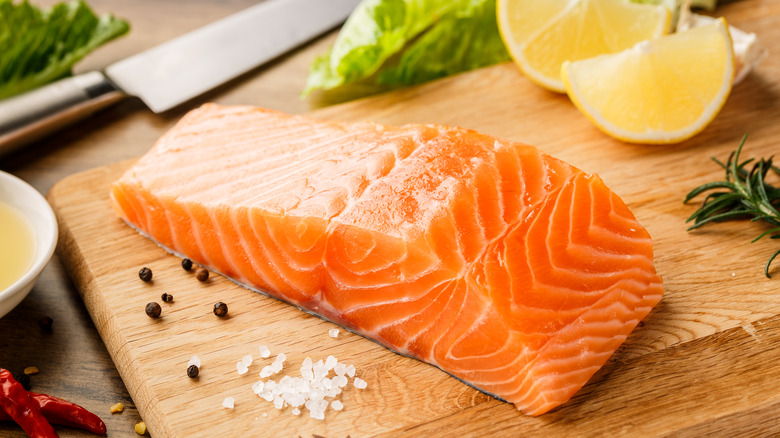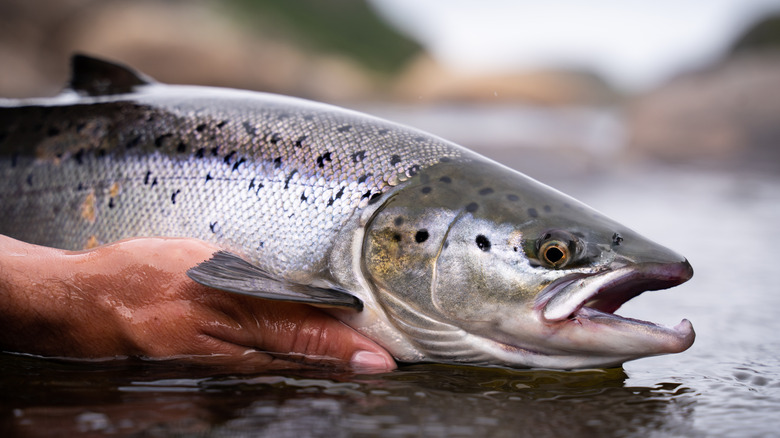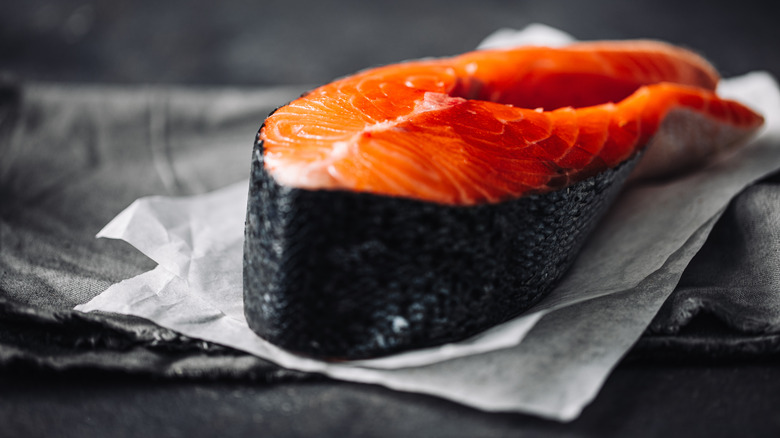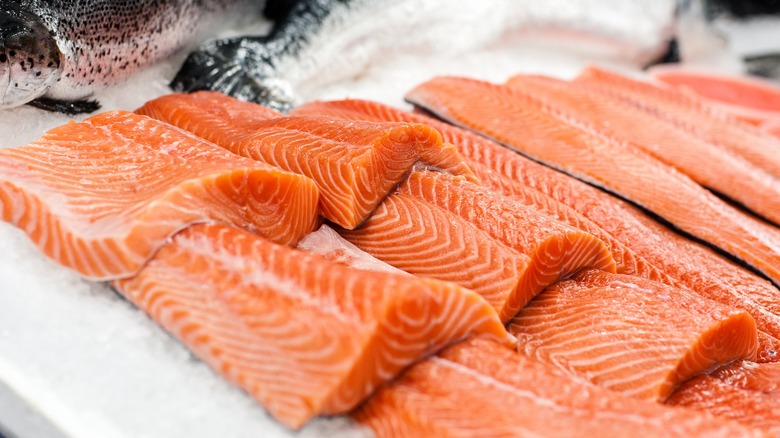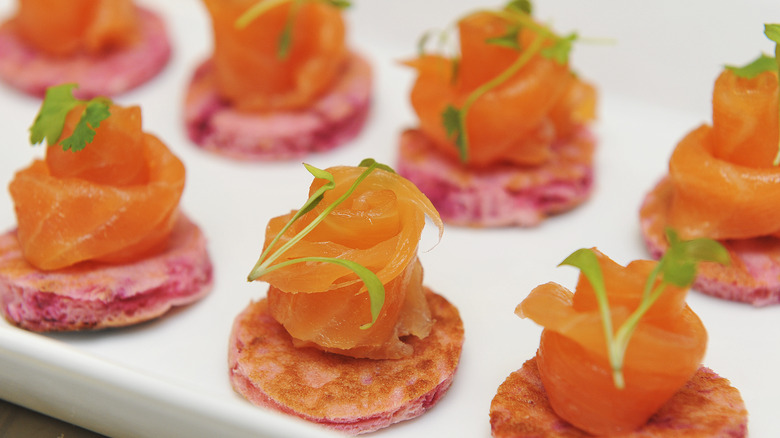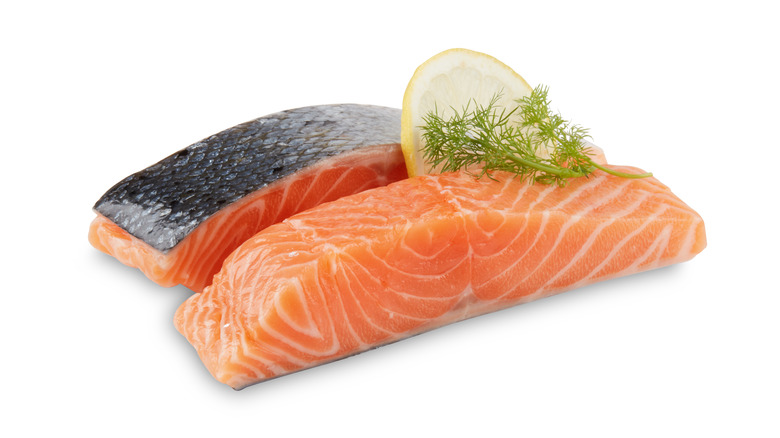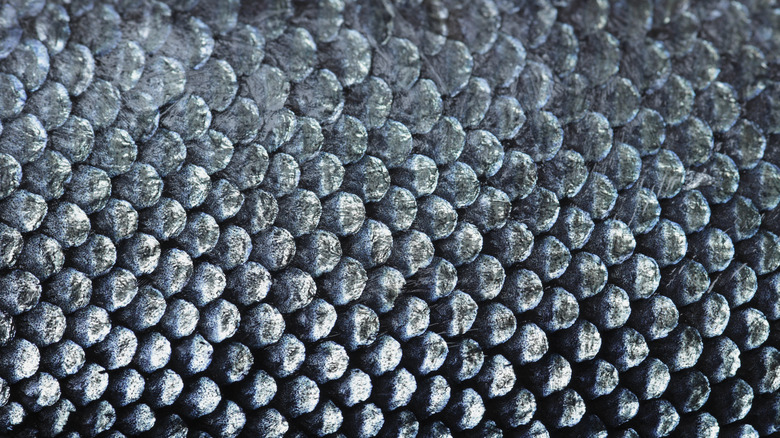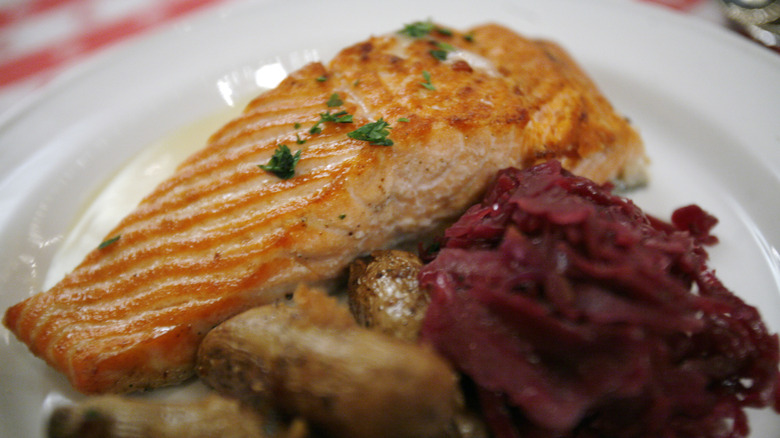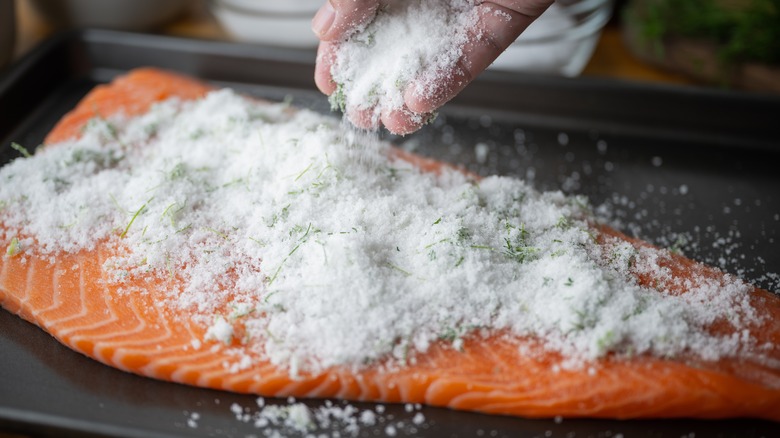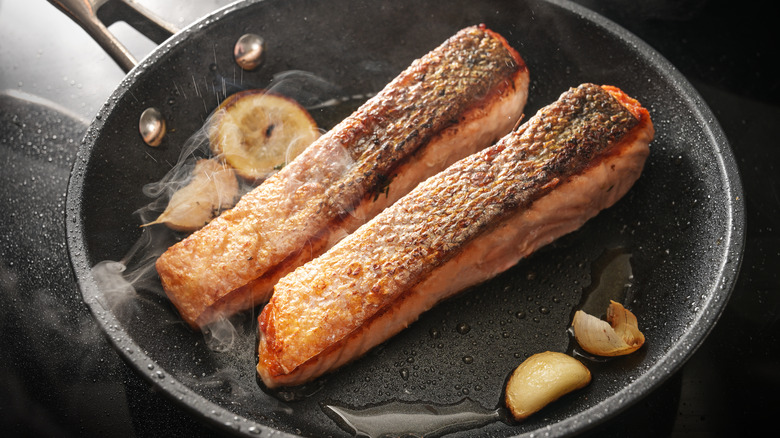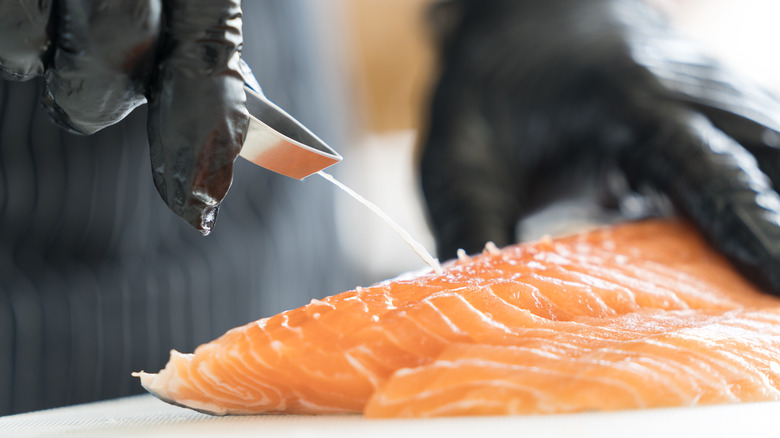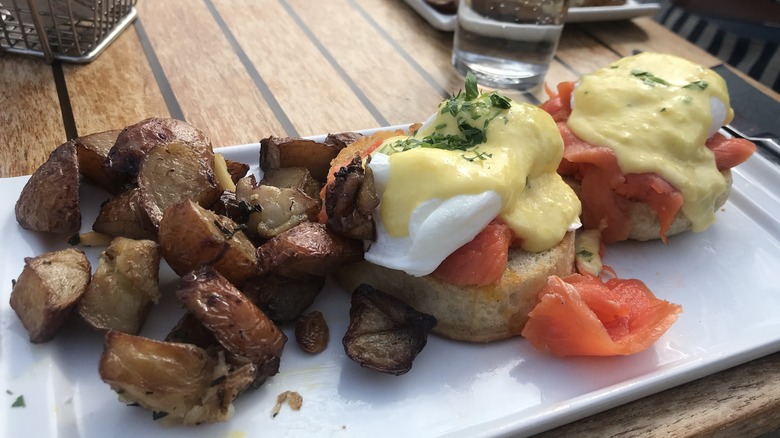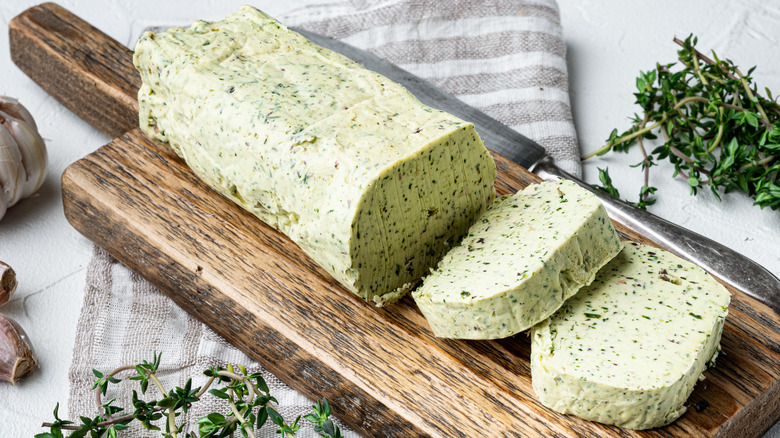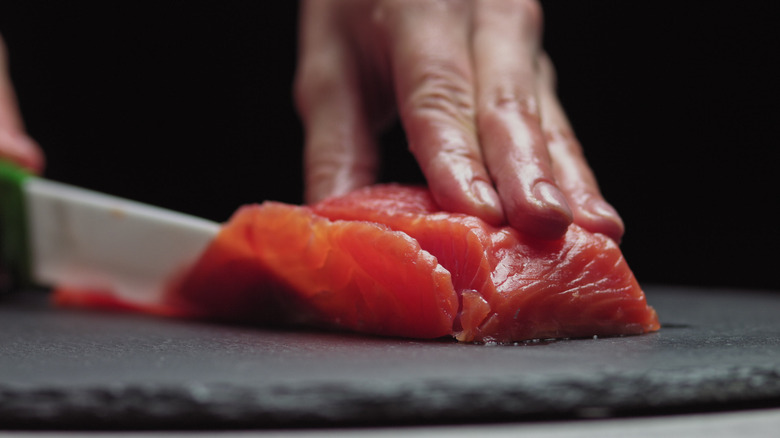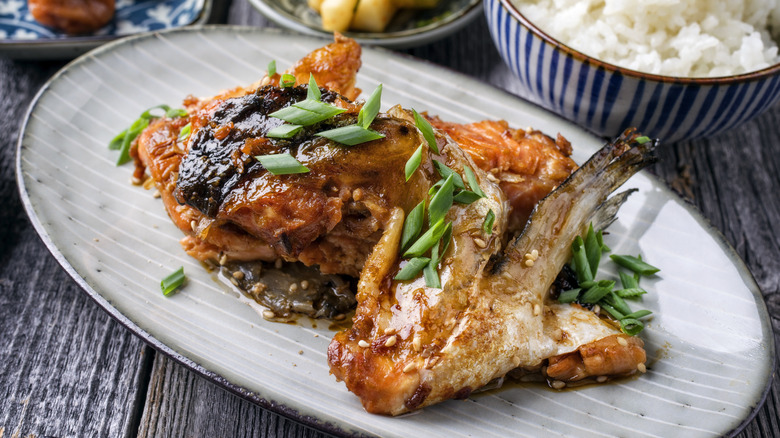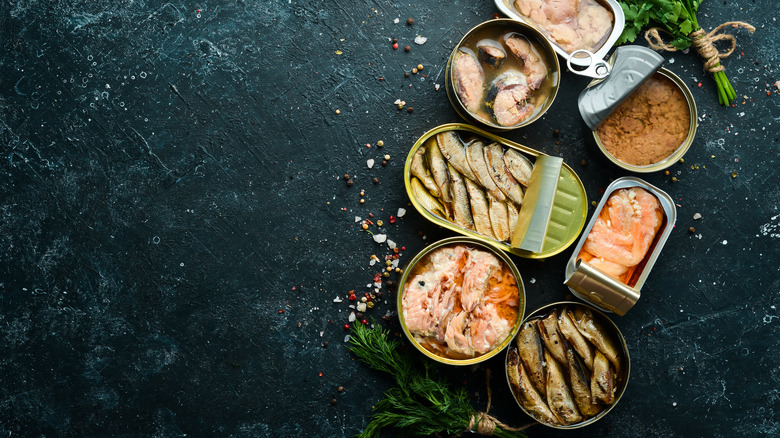15 Mistakes You're Making With Salmon
When it comes to cooking salmon — be it a fillet, a steak, sliced raw as sashimi, as an entire fish, or in any of the other delicious ways this beloved selection of seafood can be divvied up for a bite to eat — there are a million and one mistakes you can make ... mistakes that can derail the entire meal before it even hits the pan. And, with a not-so-inexpensive fish such as salmon, these mistakes can take an already pricey cut of fish and turn it into a steaming pile of something you certainly wouldn't pay to eat (and possibly couldn't even pay someone else to eat either).
From how you select your salmon at the market to the ways in which you store, prep, cook, and serve it at home, this particularly popular seafood needs just a little extra know-how to take it from drab and dry to perfect every time. So, without any further ado, let's jump into the worst mistakes you're making with salmon and talk about ways to mitigate those mishaps before they have a chance to happen.
1. Not considering farmed vs. fresh
It is impossible to discuss mistakes made with salmon without first touching on the age-old dispute: farmed salmon or fresh? To be clear, farmed fish and fresh fish are not made the same, and each has qualities that will lend to certain dishes, lifestyle preferences, and so on. While farmed salmon could be higher in some contaminants and heavy metals, wild-caught salmon isn't without its own list of ingredients that aren't all that good for people, bears, or other salmon-loving foodies either.
So, the biggest mistake you can make with salmon (at least when it comes to choosing it) is deciding on farmed or fresh for any reason other than your own personal preferences, limitations, and the desired outcome of the dish you are making. It's important to know what kind of salmon you're planning to snack on, but not so important to adhere to what others tell you is right or wrong with your own preferences. Just make sure to check for added dyes and restrict salmon (and seafood) consumption to a few times a week, which should keep farmed of fresh contaminants at healthy levels.
2. Falling for red dye
When you try to imagine a slice of salmon, you probably immediately jump to an image of a generic grey-scaled fishy exterior with vibrant, brilliant, downright stunning pink-red flesh on the inside. After all, that's what most of us have been conditioned to consider as the quintessential color of all things salmon. There's even a color called salmon pink! But, believe it or not, many of those stark pink salmon fillets are dyed red to entice shoppers, as the non-wild caught salmon diet doesn't result in that natural pink color most salmon fans expect.
Though this mistake isn't on the consumer to address, it is up to them to select fish without dyes if such decisions are important to the individual's dietary desires. After all, there's no reason to buy dyed fish when the flavor is the same with or without the classic color to accompany it. And, if that red is really important, just buy fresh fish or consider natural alternatives such as beets for that pop of color.
3. Not finding the right flavor/fat fish
Not all salmon is created equal(lly fatty), especially considering how many types of salmon there are out there. Really though, there are a ton of different kinds of salmon, though most people never learn the difference even between Atlantic Salmon and Pacific Salmon. And even then, Pacific Salmon is a category that is actually comprised of Chinook, Chum, Soho, Pink, and Sockeye Salmon. This begs the question: which salmon is the best salmon?
Well, the best salmon is usually the salmon you have on hand and available. But knowing the properties of the kind of salmon in your skillet means more power in adding, taking away, or otherwise rendering the best fat and flavor from that fishy fillet. King, for instance, is considered the best and most desirable kind of salmon for its texture and taste, while Chum is considered by many to be drier and less flavorsome. In light of this knowledge, it's easy to infer that King Salmon is best served plainly so that the quality of the meat may shine through. Alternatively, Chum Salmon makes an excellent addition to meals with stronger flavors to carry the less high-quality cut. And remember, even in a single fish, the range of fat can vary drastically since the flesh near the tail tends to be tougher and leaner than collar, cheek, and belly meat (due to its more frequent use/exertion).
4. Sticking to just one salmon recipe
Everyone and their mother seems to have their single recipe for salmon that rears its head time and time again any time this particular fish hits the menu for the evening. But it simply doesn't make sense to underestimate or dismiss the versatility of this particular fish; and though everyone loves a salmon fillet served whole with some lemon and butter and a side of rice and greens, there are (so) many more ways to enjoy salmon. That's why it's important to avoid tunnel vision with this fish and be sure to explore the plethora of options for flavors and flair.
Instead of searing your salmon with salt and pepper, try grilling your salmon, steaming it, baking and/or broiling it, serving it in, on, or around a salad ... the list of salmon recipes goes on and on. Whether you wrap it up for an app with some bellinis and caviar or you serve it up with a fun new seasoning blend and smoked on a cedar plank, salmon deserves the dignity of versatility in the recipes it's used in.
5. Removing the skin entirely
Salmon skin — you either love it or you hate it. And though the preferences per plate of salmon skin can vary greatly, it's important to remember that you can always not eat the salmon skin if it's there, but you can never eat it if it's absent. In more simple terms, unless you're baking the salmon into a fish pie, deep frying it, or otherwise purposefully leaning the skin off for a very good culinary reason, then it is most likely a good call to sear off that outer layer of salmon and serve it crispy with the skin side up (just in case someone wants a healthy, delicious, crispy, and hopefully salty snack with their salmon).
When you remove the skin of the salmon entirely, it is a huge mistake, wasting one of the most flavorful, nutrient-dense, and overall desirable cuts of fish. And even if you don't want to eat the skin, it's a great protective later during the cooking process — one that imbues the salmon with extra flavor and fat and keeps the heat from drying out the meaty layer underneath.
6. Descaling the salmon wrong
Yes, it's true — descaling salmon, or any fish in general, is a difficult (nigh on thankless) task. But all that effort of removing those scales from the skin is well worth the end result, which is the ability to avoid mouthfuls of scales with every bite of otherwise sumptuous salmon. After all, there's nothing that can ruin a heaping pile of fish on a fork quite like a hulking pile of scales intermingled beneath all that delicious fish. You take a bite, expecting the best, and instead, you get an entire experience of chewing between fish scales as they coat your tongue, stick to your cheeks, and lodge themselves between your teeth. In other words, good luck getting those out!
So, if you're going to cook salmon with the skin on, make sure to run your hand up the skin (from tail to gills) and see if your fingers catch on any scales. If there are scales, then know the proper way to descale a fish is to simply run your sharpest knife against the grain again and again until no more scales remove themselves in the process. And, if you can't figure out how to scale the fish, simply ask the butcher to do it for you. They're usually happy to help and will ensure your fish dish is absolutely scale-free and delish.
7. Criminally overcooking the fish
Salmon is a lot like steak, meaning that almost everybody overcooks it and turns an otherwise tender cut of meat into a dry and tasteless piece of protein. It seems almost as though every time a piece of salmon is cooked, you see that unmistakable whitish-gray matter collecting on its exterior, which means the fish is officially overcooked. See, that telltale visual indicator of white collecting on the outside seams of the salmon means that the fish fat has been cooked out and is now bursting from the sides of the fillet, leaving the fish still cooking in the pan decidedly dry.
To avoid this mistake, simply apply regular meat measures to your fish, like removing the salmon from the pan before it is entirely done and letting it rest on the side while you prepare the rest of the meal. This ensures the salmon has a chance to rest and finish cooking without overcooking. The end result? A piece of poisson so melt-in-your-mouth tender that you'll second guess any salmon you've cooked before. After all, finding the right internal temperature is critical when it comes to palatable salmon.
8. Under-salting the salmon
Salt is an amazing ingredient that just goes really, really well with salmon. In fact, salt and salmon are a match made in seafood heaven. And in some salmon-eating cultures (such as Japan), salted salmon is an incredibly popular dish. This is due to the qualities salt is known to somehow bring out of an otherwise predictable fish. And, when salmon is prepared with heavy salting before popping into the pan to fry, the salt acts effectively to kick back the more "fishy" flavors of salmon, leaving a perfectly salty, crispy, savory salmon snack anyone will love.
So, though salmon may live in saltwater, that doesn't mean you should assume the meat is already salty and that you shouldn't salt your salmon properly before eating. After all, there's a reason salted salmon is a staple dish across the world — and that reason is because it tastes delicious together. No fuss, no muss, and absolutely no exaggeration; just some tasty, salted salmon.
9. Not crisping the skin enough
There's nothing more dissatisfying than receiving a steaming hot plate of fish, only to see the entire dish is comprised of the same exact texture — soft rice, soft vegetables, and soft fish, all without a crunch, munch, or crisp in sight. With fish skin, a satisfying snap is essential, and not getting that crispy skin is perhaps the most common mistake people make when cooking salmon. After all, there are so many ways you can accidentally ruin crispy salmon skin along the way: removing the skin, not cooking it skin side down to start, covering the pan after you've seared the salmon skin, serving the salmon skin side down, or even pouring a sauce over the skin when it's on the plate (thus ruining an otherwise perfectly crunchy fish skin experience).
All that goes to show, is if you're going to bother to cook salmon, make the salmon skin extra crispy by simply heating a pan to a rip-roaring temperature, putting some high-temperature cooking oil in the pan, and letting it get to shimmering heat. Then, put the salmon skin side down in the pan, press it down, and cook it until a fork can't drag across that skin without a satisfying "I'm crispy" sound accompanying it.
10. Skipping the search for bones
Nothing screams "I made a mistake" quite like that moment of panic when you realize you or someone you care for has swallowed a fish bone. Whether it gets stuck in the throat, pokes your tongue, or becomes lodged in a tonsil, there's no fun scenario that can unfold from that moment when you come to the realization that you've accidentally found a salmon bone in your bite of fish.
Though most salmon fillets are labeled as fish that's been deboned, that doesn't guarantee an entirely boneless fish. In fact, there's often a bone or two that sneaks between the cracks, which is why checking your salmon for bones before cooking is a must-do. To do this, simply take your finger to the raw fish and run it against the grain (from tail to head) along the spine area. Feel for pokes or protrusions and, if you find a fish bone, remove it with either your fingers, tweezers, or pliers. Trust — it's much better to remove bones during dinner prep than during dinner itself.
11. Eating salmon only for dinner
With salmon, one of the biggest mistakes people make is when they automatically assume it is an ingredient that is only useful for dinnertime meals with the occasional and ever-so-indulgent salmon luncheon as a treat. But alongside the standard salmon dinner fare, this famously delicious fish also makes an amazing breakfast, brunch, and lunch food (as can be seen in and across many cultures).
Lox bagels piled high with salmon, cream cheese, capers, tomatoes, and red onions are an excellent use of salmon for breakfast. One can also cook salmon-centric savory oats or eggs Benedict with smoked salmon for classic salmon breakfast and brunch staples. For lunch, salmon is equally versatile and has a place in burgers, sandwiches, salads, and more. Frankly, there is no rule that dictates when and how salmon may be consumed. And, probably more out of habit than anything else, many dismiss salmon's breakfast, lunch, and brunch qualities whilst completely ignoring how amazing it is to sit down to a salmon breakfast. Just give it a try — you won't regret it.
12. Not topping it with compound butter
Compound butter is every chef, caterer, and home cook's secret weapon — an unsung hero in their arsenal of awesome accouterments to otherwise somewhat average dishes. And hey, when combining butter and a few simple ingredients can take a dish from "meh" to "omg," it makes sense that the professionals want to keep this tip close to their chest. But consider this ... compound butter is, in many cases, the reason why restaurants can get away with charging $50 for a $5 portion of salmon.
And since compound butter is such a versatile ingredient, one that can be made to be both savory or sweet, meaning honey and hot chili compound butter is just as reasonable a garnish for salmon as garlic and herb. Salmon is great with lemon, dill, and garlic compound butter as well as the a-list anchovy butter. To make compound butter at home, simply mix your favorite flavors in some room-temperature butter. Then slice and serve with salmon (or any other entree) and bon appetit, mon amie.
13. Not using sushi-grade salmon for raw dishes
There is no salmon mistake worse than the all-too-familiar faux pas of thinking that any old salmon bought at any old place can but sliced raw and served over rice — yikes. There is a very good reason that premium sushi-grade salmon is sold with that specific categorization slapped on the label, and it certainly is not one of those inexplicable grabs one sometimes suspects local grocers and fishmongers to do to get an extra dollar or two per pound of product.
No, the reason for whether or not raw fish is labeled as "sushi grade" is because sushi grade fish (salmon included) is mandated by law to be flash frozen before it can be sold for consumption, at least in the United States. After defrosting the fish the right way, few (if any) can tell the difference between frozen and "fresh." And luckily, there are many places to buy sushi-grade salmon, and there are also many alternatives to raw fish. And you can always make baked salmon sushi to completely guarantee your salmon is free of parasites, food poisoning, and all the other potential raw fish risks.x
14. Skipping out on the collar
Move aside fillet of fish — there's a new slice of seafood in town that's absolutely taking the world by storm. It isn't the succulent underbelly, nor is it flash-fried fins ... no, the cut of salmon currently craved across the nation is the collar cut of the fish. Yes, believe it or not, the salmon collar is one of the most delicious delicacies that can be made, even with the ability to pick and choose from an entire salmon (or any fish, really).
The salmon collar is everything you want in a bite of fish — you can eat it with your hands, it's perfectly fatty, flavorful, melt-in-your-mouth tender and simultaneously crispy and crunchy, and (in terms of fresh seafood) is relatively affordable. Trendy restaurants have been on the fish collar scene for a while now and many serve fish collars as appetizers for hungry patrons who don't want to drop an entire wallet on a bit, no matter how delicious it may be.
15. Not consider canned salmon
Canned fish is, in general, vastly underrated in terms of the quality of the fish compared to the quantity of money spent on said fish — from sardines to octopus to all the tuna in between, the success of the canned fish industry goes to show that there is absolutely nothing wrong with picking up a can of salmon every now and again.
But won't you taste the difference between fresh-cooked salmon fillets and that stuff that's been in a can for who knows how long? Well, it honestly depends. For instance, yes, you would certainly notice the difference between canned and fresh salmon if it were served where you would typically expect to see a steak, fillet, or otherwise whole piece of fish. But the best way to use canned fish is in dishes such as salmon cakes, risotto, salad, onigiri, and any other form of preparation in which the fish is flaked and well flavored, there is a low chance that you (or anyone else) will be able to tell the flavor of freshly caught fish from that of canned and stored salmon.
